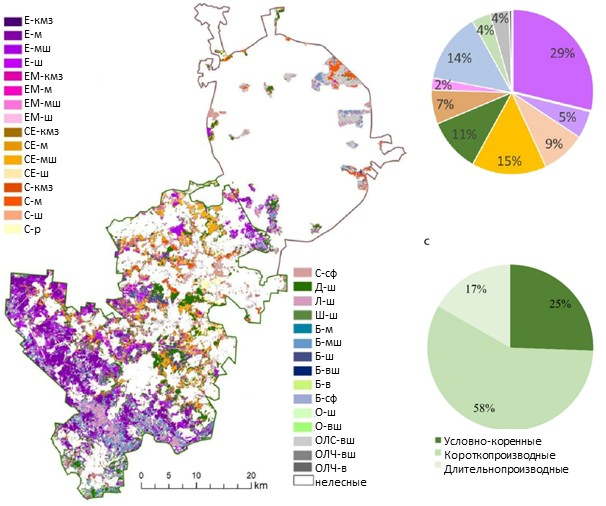
Urban forests provide ecosystem services: temperature regulation, air purification, carbon sequestration, biodiversity conservation, etc. To assess the condition and develop management measures, it is important to ensure a baseline assessment and further regular monitoring of biodiversity, vegetation dynamics and spatial structure of urban forests. For most cities, a unified monitoring system has not been developed that would allow systematically carrying out such work and integrating their results and recommendations into the existing urban area management system.
The territory of Moscow is extremely heterogeneous in the context of different types of land use, which in turn determines the different functions and condition of urban forests. To what extent do the forests of modern Moscow support the natural resource and environmental potential and what are the risks in meeting the social and environmental needs of the population in the urban region? The assessment was carried out for three sectors characterized by different anthropogenic load and land use: 1. “old Moscow”, 2. “new Moscow” up to the A-107 highway and 3. beyond the A-107 highway.
The study assessed three aspects of the condition of Moscow's forests. Firstly, typological diversity was studied (heterogeneity of forest types: coniferous, broad-leaved, etc.). Secondly, the stages of forest succession were studied: the extent to which the forests are old-growth, indigenous and, therefore, valuable, or vice versa, young - for example, long-term derivatives in overgrown clearings. The third aspect is the fragmentation and mosaic nature of forests - how small and disconnected they are or, on the contrary, how they are grouped into large coherent masses. About 1,700 field geobotanical descriptions were used to classify forest formations and groups of associations. The Random Forest algorithm was used for cartographic modeling. Elementary territorial units of forest cover (divisions), with their assigned membership in formations and groups of associations, were the object of analysis of the diversity, dynamics and spatial structure of forests.
As a result of the classification, 11 forest formations and 33 groups of forest cover associations were identified. Overall accuracy of mapping modeling was 59% for association groups and 67% for formations. With distance from the center, an ambiguous trend is observed: despite a significant increase in the share of forest cover from 9% in the center to 56% on the periphery, there is a slight decrease in typological diversity due to the dominance of pine forests in the second sector (32%) and spruce-small-leaved forests in the third sector (39%). The share of conditionally indigenous forests is steadily decreasing from the center to the periphery, and the share of long-term derived forests, on the contrary, is increasing. In terms of fragmentation, multidirectional processes are also observed. The average area of a forest stand, the complexity of shape, the similarity and proximity of stands increase from the center to the periphery. However, there is a decrease in the share of the ecological core in the patch (in conjunction with an increase in contrast), and at the same time, a decrease in connectivity between the patches.
Based on the study, it is shown that the combination of significant fragmentation with a high proportion of long-term derived forest types is critical for the sustainable existence of forest cover in the region. The unsatisfactory ability of forests to meet the social and environmental needs of residents in the central part of the city is quantitatively substantiated. In general, the methodology and results of the work create the basis for monitoring Moscow forests, as well as other urban areas.
Article: Kotlov, I., Chernenkova, T. & Belyaeva, N. Urban forests of Moscow: typological diversity, succession status, and fragmentation assessment. Landsc Ecol 38, 3767–3789 (2023). https://doi.org/10.1007/s10980-023-01788-7
